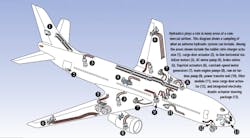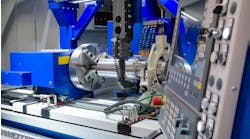Aircraft hydraulic systems can be a challenge to design engineers, due to many constraints that are not encountered when designing a system for in-plant or mobile applications. Hydraulic technology first gained a foothold in aircraft flight control during World War II, when hydraulics was introduced for some secondary systems' control. However, as aircraft flight performance and capabilities increased, hydraulics began to play a larger role in the critical operation and safety of airliners, helicopters, and high-performance military aircraft.
In modern aircraft, some of the places that hydraulics come into play include primary flight controls, flap/slat drives, landing gear, nose wheel steering, thrust reversers, spoilers, rudders, cargo doors, and emergency hydraulic-driven electrical generators. Military aircraft also use hydraulics on gun drives, weapons-bay doors, and hydraulic-motor-driven-fan heat exchangers. Factors that must be addressed on an aircraft include pressure conditions (both internal and ambient), temperature extremes, weight, speed, materials, reliability, fluid compatibility, leaks, cost, noise, and redundancy.
Pressure and temperature
Pressures on aircraft hydraulic systems run higher than on many industrial applications, which generally remain in the 1,500 to 2,000 psi range. Most commercial airliners run at 3,000 psi, with military planes using 4,000 psi systems (although some new military aircraft have made the move to 5,000 psi). The impetus for higher pressures comes from space considerations and the need for light weight, because actuators can generate higher torque forces and power from a smaller envelope.
Not only must the systems deal with the expected variables in ambient temperature that are experienced across the whole of the planet's surface, but temperatures fall well below zero at an aircraft's cruising altitude. Most commercial systems are designed to tolerate conditions from –65° to 160° F, while military aircraft can handle a temperature range of –65° to 275° F.
Fluids for high and low temperatures
Fluids used on aircraft have a relatively flat (compared to industrial fluids) viscosity vs. temperature curve — in other words, they are somewhat thin. Additionally, these fluids must be fire resistant, a critical concern when the nearest fire department may be only five miles away — but five miles straight down. One characteristic of aircraft hydraulic fluids that makes them unique is that they remain fluid at –65° F, a temperature at which water- and vegetable-based oils will freeze.
The current fluids of choice in the aerospace industry are:
MIL-H-5606 — first introduced over fifty years ago and still used on many aircraft. Used on business jets and many U.S. Air Force aircraft, it is highly flammable and considered responsible for the loss of at least one military aircraft, due to the fire created.
MIL-H-83282 — first used by the Air Force in 1982 and the U.S. Navy in 1997, it is less flammable than 5606, but much more viscous at low temperature. The lower temperature limit of MIL-H-83282 is considered –40° F, and it is used in virtually all Navy aircraft.
MIL-H-87257 — this newest fluid is used in C135, E3, and U2 aircraft; it is less flammable than 5606 (similar to 83282) but its viscosity at low temperatures allows use down to –65° F. Considered the fluid of choice for newer aircraft being developed, and
Skydrol and Hyjet — these alkyl phosphate ester based fluids are used on commercial aircraft, and are less flammable than the military fluids described above. Maximum temperature limit is 160° F. These fluids have been around at least since the 1960s.
Leakage is a concern whether the plane is on the ground or in the sky. A symposium has been held at the SAE A-6 meeting to discuss zero-leak technology, and future meetings involving aircraft manufacturers, component suppliers, and aircraft users are expected. Details on this reduced-leakage initiative is covered under "Zero Leakage Hydraulics initiative launched by SAE Committee," at the end of this article.
Component and system reliability
Great emphasis is placed on maintenance schedules, filtration, and general maintenance of fluid conditions on aircraft. Ed Bush, of Vickers Industrial & Mobile Group, Rochester Hills, Mich., explains, "In industrial applications, the PLC is operating the system, so you design it accordingly. On mobile equipment, who knows who operates it? You hope people who know what they're doing. On aircraft, the reliability is so critical, you have to throw everything in — redundant systems, very specific maintenance schedules, and stringent guidelines on the components themselves."
Parts manufactured for use on aircraft do face much tougher guidelines on design, construction, and quality control than those used in most industrial applications. A typical hydraulic pump used on an aircraft may cost between $4,000 and $25,000, compared with a comparable industrial pump's cost of $400 or less.
Why these extra costs? Consider the following differences on a pump:
- Great attention must be paid to shoe bearing plates and plate faces, due to poor fluid qualities.
- The pump must be compatible with these poor-quality fluids.
- Aluminum is often used, due to weight considerations.
- It must be smaller and have a higher operating speed.
- It must be built to withstand severe vibration, shock and g-forces. (Helicopter applications see more extreme vibration and shock forces than a shop floor does.)
Even the packaging of many components is more exotic than with the average industrial component. Phil Galloway, engineering manager, military programs, Vickers Aerospace Marine Defense Fluid Power Div., Jackson, Miss., offers, "Since minimum weight is the single most important objective, it is unlikely that the exact valve is available. Thus, it will most likely need to be modified. Each added valve is usually custom designed to suit its function. Since aircraft quantities are relatively small, modular, low-cost, mass-produced valves are not generally used."
Bootstrap (pressurized) reservoirs are used on military aircraft to keep the charge inlet of pumps pressurized to prevent cavitation. Imagine the problems that could result if a military fighter used a traditional industrial reservoir and executed a roll. Commercial airliners often use reservoirs with an air charge. Space and weight limitations in aircraft demand that reservoirs be much smaller than they are in conventional hydraulic systems. Reservoir size is optimized for aircraft so that only the amount of fluid needed for proper function is carried.
Sizing considerations often include:
- differential volume requirements due to actuator differential areas,
- volume required to fill accumulators when totally discharged,
- volume required to make up fluid when total thermal contraction and expansion of fluid is experienced, and
- amount needed to minimize the frequency of filling.
There is currently a focus on building quality systems on a system level. As part of this movement, aircraft companies are increasingly looking to component manufacturers to provide complete aircraft hydraulic systems, instead of a myriad of unconnected parts.
The majority of aircraft have three or four redundant hydraulic systems, which are geographically separate in many cases (especially on fighting aircraft, which must be able to survive being hit by enemy fire).
Particularly interesting is the RAT, or Ram Air Turbine. This last-gasp system comes online in an extreme emergency. The RAT is a spring-loaded device usually located near the nose of the plane, which is deployed in case of a total loss of power. The RAT basically consists of a propeller that turns a hydraulic pump - providing enough power to allow the pilot to make rudimentary landing gear and aileron adjustments upon landing. Its only drawback is noise - commonly on the scale of 120 dBA.
Other factors
When people talk about noise control, they usually aren't referring to airline hydraulic systems. After all, why bother tweaking a system to achieve a noise level several decibels lower, when the plane's engines themselves are drowning out any noise that the hydraulics could possibly make? However, aircraft engines have been engineered to run quieter in recent years both in takeoff and landing situations to appease communities in close proximity to airports. Quieter operation is also important during midflight for passenger comfort. Thus, noise has become an important issue in aricraft design.
Zero Leakage Hydraulics initiative launched by SAE Committee
The Society of Automotive Engineers (SAE) Committee A-6, Aerospace Fluid Power, Actuation and Control Technologies, launched its Zero Leakage Hydraulics initiative with a kick-off one day symposium in Lake Tahoe, Nev. late last year. Significantly, this attracted more than 200 delegates, demonstrating just how seriously the aerospace hydraulics community is treating the goal of zero leakage.
Symposium Chairman and A-6 member, Peter Amos, vice-president, sales and engineering, The Advanced Products Co., North Haven, Conn., explained why the symposium was so important. "Hydraulic flight controls have achieved outstanding levels of reliability, and have been proven over millions of flight-hours on every major commercial and military aircraft. The technology has continued to evolve, from mechanical linkages direct to the pilot's stick, to digital fly-by-wire, and now optical databuses offering immunity to electromagnetic interference."
"System pressures have been increased to save weight, and variable pressure systems offer reduced energy losses and enhanced component fatigue life. New fluids have extremely good properties over a wide temperature range and offer excellent fire-resistance, and since the fluid is constantly circulating in a filtered, closed, airless system, thermal and contamination management is straightforward and effective."
"SAE A-6 has been at the forefront of all these advances over the last 56 years, but one pesky problem still exists: leakage. So A-6 decided it was time to deal with this head-on and the idea for the zero leakage initiative was born. It was clear that tolerating drips was creating customer dissatisfaction and an unnecessary negative image, that was bad for the entire hydraulics community."
The symposium was structured into different parts: firstly to answer the question, "How much do aircraft leak?" and secondly to seek advice from the experts in the industry, "What can be done to eliminate leakage?".
Major contributions to part one were provided by Boeing, several major airlines (data collated and analyzed by Dr Ron Zielinski), the U.S. Navy, and Boeing McDonnell Douglas Aircraft and Missiles. These presenters showed an improving trend, but still problems in the area of tubing, fittings, and seals.
Part two invited input from several seal manufacturers, U.S. Air Force Wright Laboratories (fluid formulations and elastomers), Moog Inc. (flight controls), Parker Abex GmbH (hydraulic pumps) and two fitting suppliers. Kelly Fling provided an insightful and down to earth summary on eliminating leaks and all the presenters gave examples of leakage success stories, where attention to detail, supported and encouraged by the customer, had virtually eliminated leakage in specific cases.
Another goal of the symposium was to promote a vision of zero leakage, as an achievable and realistic goal. In his keynote address, Jim Bloomquist, of Vickers, Inc. encouraged aerospace engineers to look at advances made in zero leakage industrial hydraulics and refrigeration, as an example of the progress that can be achieved. Vickers also closed the Symposium with an uncompromising call to overcome the leakage paradigm.
Following this successful meeting, a task force within A-6 continues to gather and sift data from commercial and military aircraft operators, feeding this back to the appropriate sub-committees and technical panels for action. A-6 is therefore offering leadership on this issue, by focusing attention on the problem, challenging the industry to do better and then through detailed committee work, seeking to apply much tighter leakage requirements through improved aerospace standards.
The first tangible results of SAE action are expected to be a revised standard for qualifying separable and permanent fittings and tubing (AS 4401); inclusion of tighter tolerance options in the AS 568 elastomeric O-ring standard; and a comprehensive upgrade to AS 4716. This is the aerospace gland design standard that replaces the widely used, but now discontinued MIL-G-5514.


